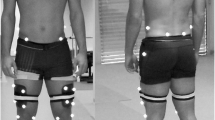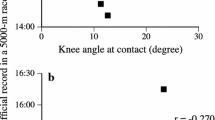Abstract
Achilles tendon injuries are common in runners. The aim of the present study was to analyse the training programme, any Achilles tendon problems, muscle eightness and range of motion of the ankle joint, and concentric and eccentric musle torques of the calf muscles in middle-distance runners with and without Achilles tendon problems. Eighty-three middle-distance runners answered a questionnaire on their sports background, training habits and any injuries. Thirty-four percent had suffered from some type of problem relating to the Achilles tendon. Ten of the athletes who had suffered from Achilles tendon problems and ten who had never had any Achilles tendon trouble were randomly selected. These 20 runners underwent a clinical examination. The range of motion of the ankle joint was recorded objectively by a hydraulic and computerised isokinetic dynamometer by measuring resistance to passive motion. Concentric and eccentric muscle torques of the gastrocnemius-soleus complex were recorded. The runners with Achilles tendon problems had trained for significantly more years and covered significantly longer distances per weck than runners without Achilles tendon problems. There were no significant differences in other training methods or in best results over 800 m and 1500 m. Runners with Achilles tendon problems had a significantly lower range of motion of the ankle joint. They also had significantly lower eccentric torques of the gastroenemius-soleus complex, but no differences in concentric torques were found between the groups.
Similar content being viewed by others
References
Allenmark C (1992) Partial Achilles tendon tears. Clin Sports Med 11: 759–769
Asmussen E (1952) Positive and negative muscular work. Acta Physiol Scand 28: 364–382
Biedert R (1991) Symptoms in area of the Achilles tendon. Etiology and therapeutic considerations. Unfallchirurg 94: 531–537
Brody DM (1987) Running injuries, prevention and management. Clin Symp 39: 1–36
Clancy WG, Neidhart D, Brand RL (1976) Achilles tendonitis in runners: a report of five cases. Am J Sports Med 4: 46–57
Clarkson PM, Tremblay I (1988) Exercise-induced muscle damage, repair, and adaption in humans. J Appl Physiol 65: 1–6
Clement DB, Taunton JE, Smart GW (1984) Achilles tendinitis and peritendinits: etiology and treatment. Am J SportsMed 12: 179–184
Stanish WD, Curwin S (1984) Tendinitis: its etiology and treatment. Collamore, Lexington
Ekstrand J, Wiktorsson M, Öberg B, Gillquist J (1982) Lower extremity goniometric measurements: a study to determine their reliability. Arch Phys Med Rehabil 63: 171–175
Fridén J, Seger J, Sjöström M, Ekblom B (1983) Adaptive response in human skeletal muscle subjected to prolonged eccentric training. Int J Sports Med 4: 177–183
Fridén J, Sjöström M, Ekblom B (1983) Myofibrillar damage following intense eccentric exercise in man. Int J Sports Med 4: 170–176
Fyfe I, Stanish WD (1992) The use of eccentric training and stretching in the treatment and prevention of tendon injuries. Clin Sports Med 11: 601–624
Galloway MT, Jokl P, Dayton OW (1992) Achilles tendon overuse injuries. Clin Sports Med 11: 771–782
Gransberg L, Knutsson E (1983) Determination of dynamic muscle strength in man with acceleration controlled isokinetic movements. Acta Physiol Scand 119: 317–320
Gudas CJ (1980) Patterns of lower-extremity injury in 224 runners. Compr Ther 6: 50–59
James SL, Bates BT, Osternig LR (1978) Injuries to runners. Am J Sports Med 6: 40–50
Knutsson E (1983) Analysis of gait and isokinetic movements for evaluation of antispastic drugs or physical therapies. In: Desment JE (ed) Motor control mechanisms in health and disease. Raven Press, New York, pp 1013–1036
Knutsson E, Skoglund CR, Natchev E (1988) Changes in voluntary muscle strength, somatosensory transmission and skin temperature concomitant with pain relief during autotraction in patients with lumbar spine and sacral root lesions. Pain 33: 173–179
Komi PV, Viitasalo JT (1977) Changes in motor unit activity and metabolism in human skeletal muscle during and after repeated eccentric and concentric contractions. Acta Physiol Scand 100: 246–254
Kvist M (1991) Achilles tendon injuries in athletes. Ann Chir Gyn 80: 188–201
Kvist M, Jozsa L, Järvinen M, Kvist H (1985) Fine structural alterations in chronic Achilles paratenonitis in athletes. Pathol Res Pract 180: 416–423
Kvist MH, Jozsa L, Järvinen M, Kvist H (1987) Chronic Achilles paratenonitis in athletes: a histological and histochemical study. Pathology 19: 1–11
Kvist MH, Lehto MK, Jozsa L, Järvinen M, Kvist H (1988) Chronic Achilles paratenonitis. An immunohistologic study of fibrin and fibrinogen. Am J Sports Med 16: 616–623
Leach RE, James S, Wasikewski S (1981) Achilles tendinitis. Am J Sports Med 9: 93–98
Leppilahti J, Orava S, Karpakka J, Takala T (1991) Overuse injuries of the Achilles tendon. Ann Chir Gyn 80: 202–207
Ljungqvist R (1968) Subcutaneous partial rupture of the Achilles tendon. Acta Orthop Scand [Suppl] 113
Lowdon A, Bader DL, Mowat AG (1984) The effect of healpads on the treatment of Achilles tendinitis: a double-blind trial. Am J Sports Med 12: 431–435
Lysholm J, Wiklander J (1987) Injuries in runners. Am J Sports Med 15: 168–171
Marti B, Vader JP, Minder CE, Abelin T (1988) On the epidemiology of running injuries. The 1984 Bern Grand-Prix study. Am J Sports Med 16: 285–294
Möller MHL, Öberg BE, Gillquist J (1985) Stretching exercise and soccer: effect of stretching on range of motion in the lower extremity in connection with soccer training. Int J Sports Med 6: 50–52
Nichols AW (1989) Achilles tendinitis in running athletes. J Am Board Fam Pract 2: 196–203
Schwane JA, Armstrong RB (1983) Effect of training on skeletal muscle injury from downhill running in rats. J Appl Physiol 55: 969–975
Smart GW, Taunton JE, Clement DB (1980) Achilles tendon disorders in runners. Med Sci Sports Exerc 12: 231–243
Stanton P, Purdam C (1989) Hamstring injuries in sprinting—the role of eccentric exercise. J Orthop Sports Phys Ther 10: 343–349
Van Mechelen W, Hlobil H, Zijlstra WP, de Ridder M, Kemper HCG (1992) Is range of motion of the hip and ankle joint related to running injuries? Int J Sports Med 13: 605–610
Vitasalo JT, Kvist M (1983) Some biomechanical aspects of the foot and ankle in athletes with and without shin splints. Am J Sports Med 11: 125–130
Wallin D, Ekblom B, Gran R, Nordenberg TH (1985) Improvement of muscle flexibility. A comparison between two techniques. Am J Sports Med 13: 263–268
Author information
Authors and Affiliations
Rights and permissions
About this article
Cite this article
Haglund-Åkerlind, Y., Eriksson, E. Range of motion, muscle torque and training habits in runners with and without Achilles tendon problems. Knee Surg, Sports traumatol, Arthroscopy 1, 195–199 (1993). https://doi.org/10.1007/BF01560205
Issue Date:
DOI: https://doi.org/10.1007/BF01560205




